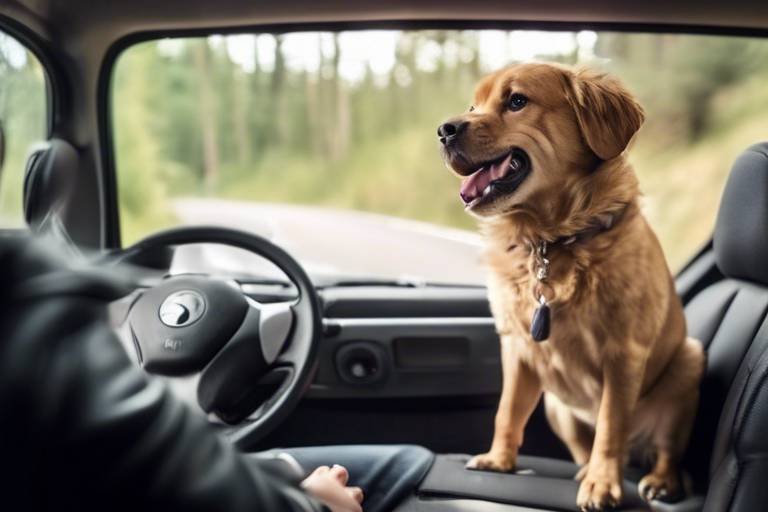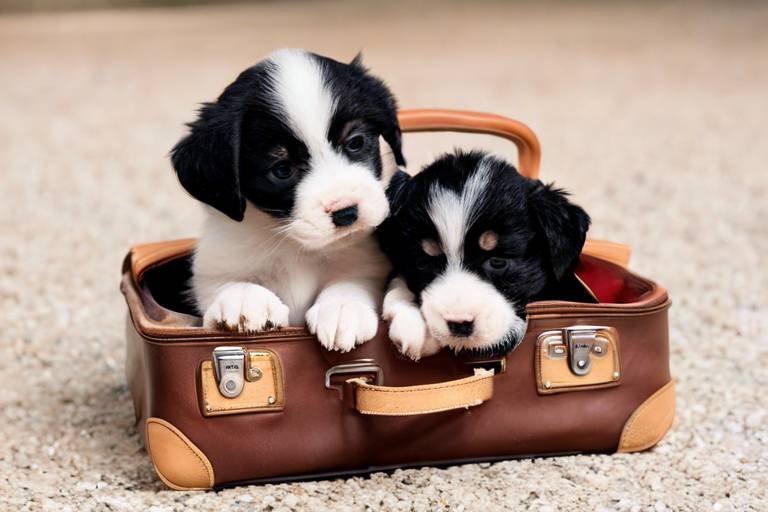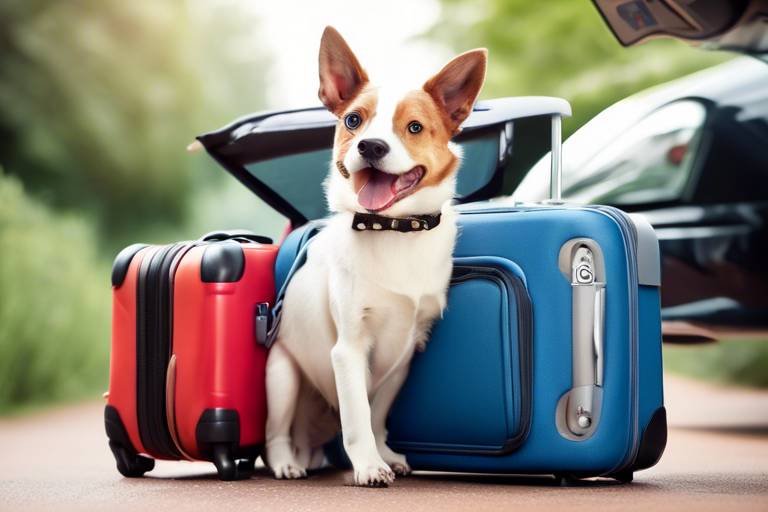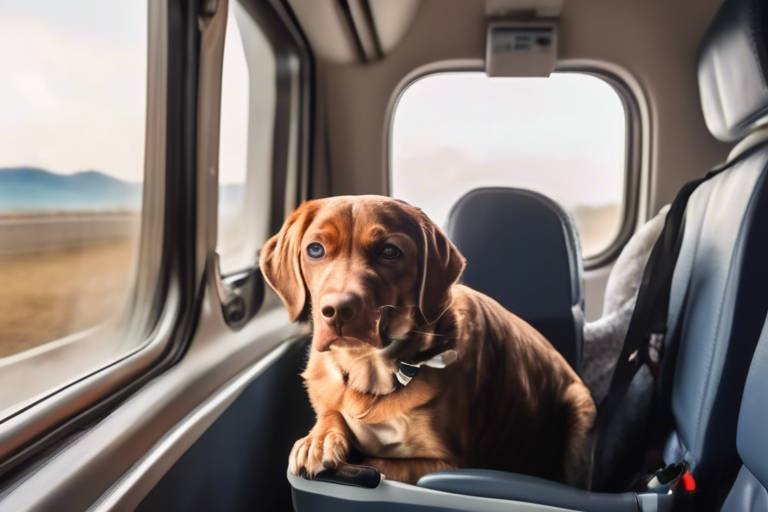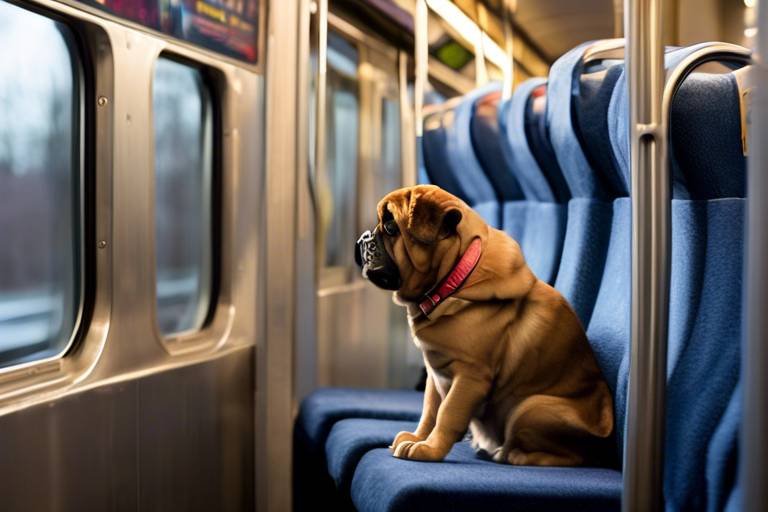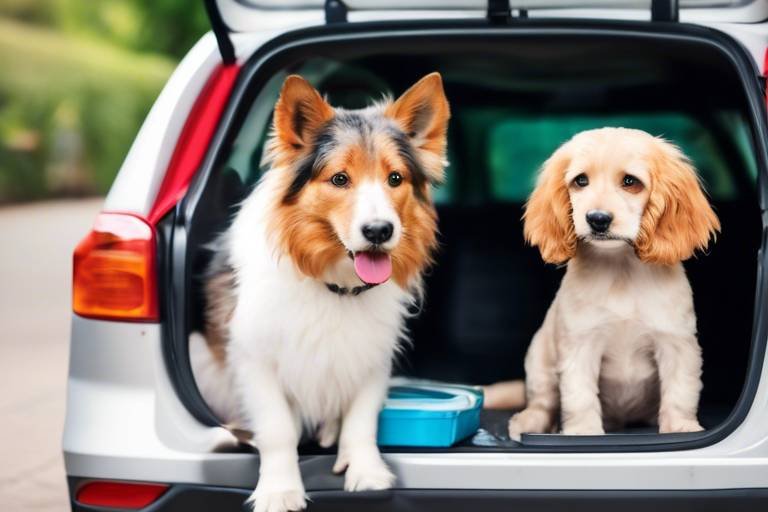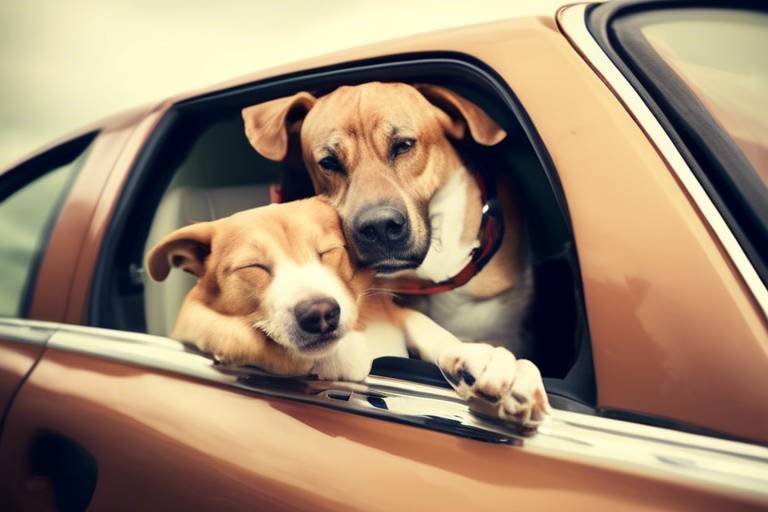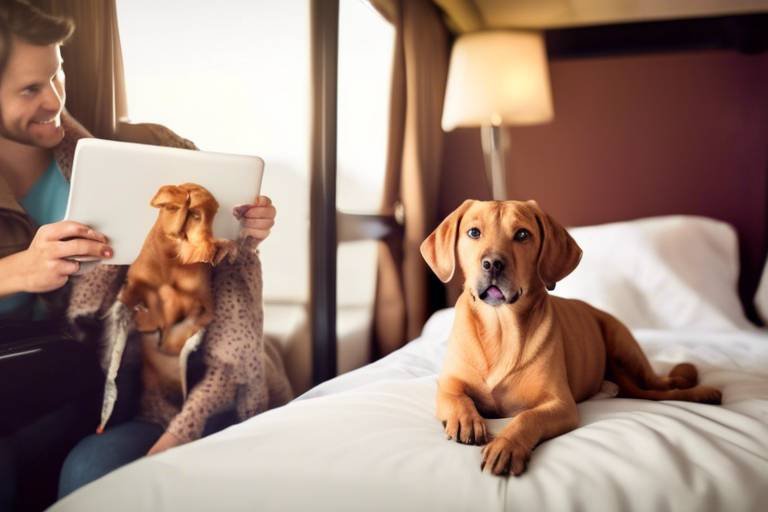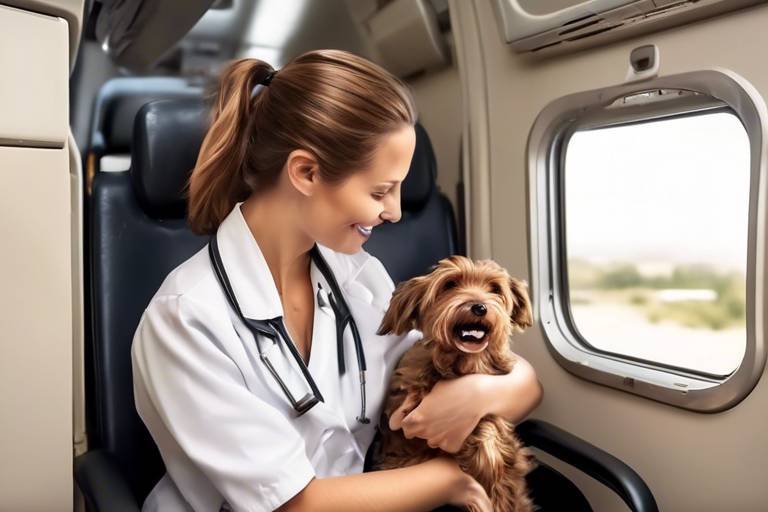How to Make Road Trips More Enjoyable for Your Pet
Taking a road trip with your furry friend can be one of the most rewarding experiences, but it can also come with its own set of challenges. Just like us, pets can feel anxious or uncomfortable during long car rides. So, how do we ensure that our beloved companions enjoy the journey as much as we do? The key lies in preparation, understanding their needs, and creating a comfortable environment for them. Imagine embarking on a thrilling adventure with your pet, where both of you can enjoy the scenic views and create lasting memories. With a little planning and some helpful tips, you can transform your road trip into a delightful experience for both you and your pet.
First things first, it’s crucial to get your pet ready for the trip. This means familiarizing them with the car before the journey begins. A few short drives around the neighborhood can help your pet adjust to the vehicle’s movement and sounds. Make sure they have a cozy spot in the car, perhaps a favorite blanket or toy, to help them feel secure. After all, just like we might feel uneasy in a new environment, our pets can experience similar emotions. By easing them into the travel experience, you can significantly reduce their anxiety levels.
Now, let’s talk about packing. You wouldn’t head out on a trip without the essentials, right? The same goes for your pet. Packing a well-thought-out bag for your furry friend can make all the difference. Here’s a quick checklist of must-have items:
- Food and water supplies
- Comfort items like toys or blankets
- Leash and harness
- First aid kit
- Waste bags
By preparing these essentials ahead of time, you can ensure that your pet remains happy and healthy throughout the journey. Remember, a well-fed and hydrated pet is a happy pet! So, keep their food and water accessible, and don’t forget to take regular breaks to let them stretch their legs. This not only benefits your pet but also gives you a chance to refresh and recharge.
As you embark on your adventure, consider the importance of making frequent stops. Just like us, pets need to stretch and relieve themselves during long drives. Stopping every couple of hours can help break up the monotony of the road and provide your pet with the opportunity to explore new surroundings. When planning your route, look for pet-friendly rest areas where your furry friend can run around and enjoy some fresh air.
While on the road, safety should always be your top priority. Ensure your pet is properly restrained in the car, whether it’s through a pet seatbelt, a harness, or a crate. This not only keeps them safe in case of sudden stops but also prevents distractions while you’re driving. Additionally, make sure your pet is easily identifiable. Microchipping and having ID tags on their collar can be lifesavers in case you get separated during your travels.
Ultimately, the goal is to create a fun and enjoyable experience for both you and your pet. With the right preparation, frequent breaks, and safety measures in place, you can embark on a road trip that strengthens the bond between you and your furry companion. So, buckle up, roll down the windows, and get ready for an unforgettable adventure!
Q: How can I help my pet feel more comfortable in the car?
A: Start with short drives to help them get used to the car. Bring along their favorite blanket or toy to create a familiar environment.
Q: What should I do if my pet gets car sick?
A: Consult your vet for advice on preventing motion sickness. They may recommend medication or tips for easing your pet's anxiety during travel.
Q: How often should I stop during a long road trip?
A: It's best to stop every 2-3 hours to allow your pet to stretch, relieve themselves, and hydrate.
Q: Are there specific pet-friendly rest areas I should look for?
A: Look for rest areas that have designated pet areas or parks nearby. Websites and apps can help you locate these spots along your route.
Q: What if my pet gets lost while traveling?
A: Always ensure your pet has proper identification, such as a microchip and ID tags. In case they get lost, this will greatly increase the chances of being reunited.

Preparing Your Pet for the Journey
Before you embark on your adventure, preparing your pet is key to ensuring a smooth and enjoyable road trip. Just like you wouldn’t head out without packing your essentials, your furry friend deserves the same attention. Start by introducing them to the car before the big day. Allow them to explore the vehicle while it's parked, offering treats and praise to create a positive association. This simple step can significantly reduce anxiety and make the car feel like a safe space.
Next, consider taking your pet on short drives leading up to your trip. This gradual exposure can help them get used to the sensation of being in a moving vehicle. During these practice runs, pay attention to their behavior. Are they calm, excited, or anxious? If they seem restless, it might be a good idea to invest in some calming products, like anxiety wraps or pheromone sprays, which can help soothe their nerves.
Another important aspect of preparation is ensuring your pet is comfortable in their travel area. You can use a pet seat cover or blanket to create a familiar spot for them to relax. This not only protects your car’s interior but also gives your pet a sense of belonging. Additionally, consider securing a pet seat belt or a travel crate to keep them safe and prevent distractions while driving. Remember, a safe pet is a happy pet!
Lastly, don’t forget to schedule a visit to the vet before you hit the road. Make sure your pet is up-to-date on vaccinations and discuss any potential travel-related health concerns. If your journey will take you across state lines, you might need a health certificate, so it’s best to check in advance. By taking these steps, you’re setting the stage for a fun and enjoyable road trip for both you and your beloved pet!

Essential Packing List for Pets
When it comes to embarking on a road trip with your furry companion, packing the right supplies can mean the difference between a delightful adventure and a stressful journey. Imagine the joy on your pet's face when they see their favorite toys and treats! To ensure your pet remains comfortable, happy, and healthy on the road, it’s crucial to have a well-thought-out packing list. Here are some essentials that should never be left behind:
First and foremost, food and water supplies are a must. Just like us, pets need to stay hydrated and nourished during long trips. Make sure to bring enough of their regular food to last the entire journey, plus a little extra, just in case. Opt for portable containers that are easy to fill and clean. You can also consider pre-measuring their meals into ziplock bags for convenience. Water is equally important; a collapsible water bowl can be a lifesaver during those pit stops.
Next, let’s talk about comfort items. Bringing along familiar items from home can significantly ease your pet's anxiety. This might include their favorite blanket, a beloved toy, or even a piece of your clothing. These items can provide a sense of security and help them feel more at ease in the unfamiliar environment of a car. Think of it as packing a piece of home for your pet; it can make all the difference!
Now, don’t forget to pack some travel-friendly treats. Treats can be a fantastic way to reward your pet for good behavior during the trip and to keep them entertained during long stretches of travel. Look for treats that are easy to carry and won’t make a mess in your car. Consider options like small, chewy treats or dehydrated snacks that are lightweight and packed with flavor.
Lastly, ensure you have a first aid kit specifically for your pet. This kit should include basic supplies such as bandages, antiseptic wipes, and any medications your pet may require. A little preparation can go a long way in handling any minor emergencies that might arise while on the road.
| Essential Item | Description |
|---|---|
| Food and Water Supplies | Pack enough food and portable containers for easy feeding. |
| Comfort Items | Include familiar toys or blankets to reduce anxiety. |
| Travel-Friendly Treats | Bring along easy-to-carry treats for rewards and entertainment. |
| First Aid Kit | Prepare a kit with basic supplies and any necessary medications. |
By ensuring you have these essential items packed, you’re setting the stage for a successful and enjoyable road trip for both you and your pet. Remember, the journey can be just as fun as the destination when your furry friend is well taken care of!
Food and Water Supplies
Keeping your furry friend hydrated and well-fed during a road trip is not just a matter of convenience; it's essential for their overall well-being. Imagine being on a long journey without access to food or water—it's uncomfortable for us, and even more so for our pets. Therefore, planning ahead is key. Start by packing your pet's regular food in a sturdy, spill-proof container. This way, you can avoid any messes and ensure that your pet receives the nutrition they're used to. If you're traveling for several days, consider bringing enough food for the entire trip, plus a little extra, just in case.
When it comes to hydration, it's crucial to have a reliable supply of fresh water. Pets can get dehydrated quickly, especially if they're anxious during travel. A good rule of thumb is to offer your pet water every couple of hours, especially during long stretches on the road. You might want to invest in a portable water bottle designed specifically for pets. These bottles often come with an attached bowl, making it easy to let your pet drink without spilling water everywhere.
While we're on the topic of food and water, don't forget about the importance of treats. Travel-friendly treats can serve multiple purposes: they can keep your pet entertained during the journey, help them associate the car with positive experiences, and even act as a reward for good behavior. Look for treats that are easy to pack and won't crumble all over your car. Some popular options include:
- Soft chews that are easy to digest
- Freeze-dried meat snacks
- Dehydrated fruits or veggies
By keeping your pet's food and water needs in mind, you can make their travel experience much more enjoyable. A well-fed and hydrated pet is a happy pet, and that happiness will reflect on your overall road trip experience!
Portable Bowls and Containers
When embarking on a road trip with your furry friend, one of the most essential items to consider is a reliable set of . These handy tools not only make it easier to feed and hydrate your pet on the go, but they also help maintain cleanliness and organization in your vehicle. Imagine pulling over at a scenic rest stop, and within moments, your pet is happily munching away from a bowl that’s easy to set up and clean!
Portable bowls come in various styles, but the best ones are collapsible and made from durable, pet-safe materials. This means they can easily fit into your backpack or car compartment without taking up too much space. For instance, silicone bowls are a popular choice because they are lightweight, easy to clean, and can hold both food and water without leaking. Plus, they often come in vibrant colors, making them visually appealing!
When selecting containers for your pet's food, opt for airtight options. Keeping your pet's food fresh is crucial, especially on long journeys. You wouldn’t want your pet to eat stale food, would you? A good container will not only keep the food fresh but also prevent any unwanted odors from wafting through your car. Look for containers that are easy to open yet secure enough to prevent spills during sudden stops or turns.
Here’s a quick overview of some popular types of portable bowls and containers:
| Type | Features | Best For |
|---|---|---|
| Collapsible Bowls | Lightweight, easy to store, dishwasher safe | Traveling, hiking |
| Silicone Bowls | Durable, non-slip, various colors | Outdoor use, water and food |
| Airtight Food Containers | Prevents spills, keeps food fresh | Long trips, camping |
Additionally, consider investing in a travel water bottle designed specifically for pets. These bottles often come with an attached bowl, allowing your pet to drink easily without the mess of traditional bowls. This is particularly useful during quick stops, ensuring your pet stays hydrated without you having to fumble around with separate bowls.
In conclusion, packing the right portable bowls and containers can transform your road trip experience. They not only provide convenience and cleanliness but also ensure your pet is well-fed and hydrated. Remember, a happy pet makes for a happy trip!
Travel-Friendly Treats
When embarking on a road trip with your furry companion, packing the right can make a world of difference. Not only do these treats keep your pet entertained, but they also serve as a great way to reward good behavior during the journey. Think of them as little nuggets of joy that can transform a long drive into a delightful experience for your pet.
First off, it’s essential to choose treats that are both nutritious and easy to handle. Look for options that are not too crumbly, as you don’t want to end up with a mess in your car. Soft, chewy treats are often a hit because they can be broken into smaller pieces, making them perfect for quick rewards during pit stops. Additionally, consider treats that are lower in calories, so you can give your pet a few without worrying about overindulgence.
Another important factor to consider is the packaging. Opt for treats that come in resealable bags or containers. This not only helps keep them fresh but also makes it easier to grab a handful without fumbling around. You want to be able to reach for a treat quickly, especially when your pet is looking at you with those big, pleading eyes!
Here are some popular travel-friendly treat options:
- Freeze-Dried Treats: These are lightweight, have a long shelf life, and are easy to pack. Plus, they often come in a variety of flavors that your pet will love!
- Peanut Butter Biscuits: Dogs adore peanut butter, and these treats can double as a tasty snack and a training tool.
- Chewy Jerky: For those pets that love a bit of chew, jerky treats can keep them occupied for a while.
While it’s tempting to share your own snacks with your pet, be cautious. Many human foods can be harmful to animals. Instead, stick to the treats you know are safe for your furry friend. If your pet has any dietary restrictions or allergies, make sure to check the ingredient list carefully before packing.
Lastly, don’t forget to bring along some water to wash down those treats. Keeping your pet hydrated is just as important as keeping them fed. You can even combine treat time with a quick water break to make it a fun little ritual during your stops.
By choosing the right travel-friendly treats, you not only keep your pet happy but also create a positive association with the journey. After all, a happy pet makes for a happy road trip!
Q: Can I give my pet human snacks during the trip?
A: While some human snacks are safe for pets, many can be harmful. It's best to stick to treats specifically made for pets.
Q: How often should I give my pet treats on a long road trip?
A: It's a good idea to give treats during breaks. This helps maintain their energy levels and keeps them engaged throughout the journey.
Q: What if my pet has food allergies?
A: Always check the ingredient list of treats and opt for hypoallergenic options if your pet has specific dietary needs.
Comfort Items
When it comes to road trips with your furry friend, packing is just as crucial as packing food and water. Think of these items as your pet's little slice of home on the road. Familiar smells and textures can work wonders to ease anxiety and help your pet feel secure in an unfamiliar environment. Imagine how you would feel sleeping in a strange hotel without your favorite pillow—your pet feels the same way!
One of the best comfort items you can bring is your pet's favorite blanket or bed. This familiar piece of fabric not only smells like home but also provides a cozy spot for your pet to curl up during the ride. Additionally, their own bedding can help them feel safe and relaxed, especially during long stretches of travel. If you have a dog, consider bringing along a chew toy or a stuffed animal they love. These toys can serve as an emotional anchor, giving them something to focus on during the journey.
Another important aspect of comfort is ensuring that your pet has a designated space in the vehicle. Whether it's a cozy crate or a pet seat cover, having their own area can help them feel more secure. A pet seat cover not only protects your car's seats but also gives your pet a familiar space to lounge. Just like we appreciate having our own corner of the couch, your pet will appreciate their own spot in the car.
Don't forget to consider calming products as well. There are various sprays, collars, and treats designed to reduce anxiety in pets during travel. These can be particularly useful if your pet is prone to nervousness or motion sickness. It's like giving them a gentle hug while you drive! Just make sure to test any new products before your trip to see how your pet reacts.
In summary, packing comfort items can transform a potentially stressful road trip into a more enjoyable experience for your pet. By bringing along familiar items, creating a cozy space, and considering calming aids, you can ensure that your furry friend feels safe and secure during your travels.
- What are the best comfort items to bring for my pet? Favorite blankets, toys, and calming products are great options.
- How can I help my pet feel secure during long car rides? Create a designated space for them in the vehicle and bring familiar items from home.
- Are there any specific calming products you recommend? Look for sprays, collars, or treats specifically designed for anxiety relief in pets.

Making Frequent Stops
When it comes to road trips with your furry friend, one of the most important aspects to consider is making frequent stops. Just like us, pets need a break from the confines of the car to stretch their legs, relieve themselves, and simply enjoy a change of scenery. Imagine being cooped up in a small space for hours on end—it's bound to make anyone a bit restless, right? So, let's dive into why these breaks are essential and how to make the most of them!
First off, regular stops help prevent your pet from becoming overly anxious or agitated. A quick pit stop allows them to shake off the car jitters, sniff around, and explore the great outdoors. This can be especially beneficial for dogs, who thrive on physical activity and mental stimulation. Just think of it as a mini-adventure within your larger road trip! You can turn these breaks into opportunities for bonding, whether it's playing fetch, practicing commands, or simply enjoying the fresh air together.
Now, not all rest areas are created equal. Some are more pet-friendly than others, so it’s crucial to plan your stops accordingly. Look for locations that offer ample space for your pet to roam and explore. Ideal rest areas should have grassy patches or designated pet areas, which can make all the difference in your pet’s comfort and enjoyment. If you’re unsure where to find these spots, many road trip apps and websites provide information about pet-friendly rest areas along your route.
Additionally, consider the timing of your stops. Aim to take a break every couple of hours, or whenever you notice your pet getting restless. This not only benefits your pet but also gives you a chance to stretch your legs and refresh yourself. During these breaks, don’t forget to bring along some water and a portable bowl to keep your pet hydrated. After all, staying hydrated is just as important for them as it is for you!
To make your stops even more enjoyable, think about incorporating some fun activities. Here are a few ideas:
- Short Walks: A quick stroll can help your pet burn off some energy and explore their surroundings.
- Playtime: Bring along a favorite toy for a game of fetch or tug-of-war.
- Training Sessions: Use this time to practice commands or tricks, which can be a great mental exercise.
In summary, making frequent stops during your road trip is not just a luxury—it's a necessity for your pet's well-being. By planning ahead and choosing pet-friendly rest areas, you can ensure that both you and your furry companion enjoy the journey. After all, the road trip is about creating memories together, so don’t rush through it. Embrace the adventure, one stop at a time!
Q: How often should I stop during a road trip with my pet?
A: It's recommended to stop every 2-3 hours to allow your pet to stretch, relieve themselves, and hydrate.
Q: Are there specific apps for finding pet-friendly rest areas?
A: Yes, there are several travel apps that specialize in pet-friendly locations. Some popular ones include BringFido and DogFriendly.
Q: What should I do if my pet becomes anxious during the trip?
A: Frequent stops can help alleviate anxiety. Additionally, bringing along comfort items from home, like their favorite blanket or toy, can provide reassurance.
Q: Can I let my pet roam freely at rest areas?
A: Always keep your pet on a leash and ensure they are in a safe, enclosed area where they can explore without the risk of running off.
Choosing Pet-Friendly Rest Areas
When you're on a road trip with your furry friend, not all rest areas are created equal. Finding a pet-friendly rest area is crucial to ensuring your pet has a comfortable and enjoyable break from the car. Imagine pulling over at a rest stop that has ample green space, fresh air, and even some shaded areas for your pet to relax. Sounds perfect, right? But how do you find such gems along your route?
First and foremost, it's essential to plan ahead. Use apps and websites that specialize in pet-friendly travel. These resources can help you identify rest areas that welcome pets and provide the necessary amenities, such as waste disposal stations and drinking fountains. It’s like having a treasure map that leads you to the best spots for your pet along the way!
When evaluating a rest area, look for several key features:
- Space to Roam: A large, open area allows your pet to stretch their legs and relieve themselves comfortably.
- Shade: Look for trees or shaded spots where your pet can cool off, especially during hot weather.
- Pet Waste Stations: These are crucial for keeping the area clean and maintaining good hygiene.
- Nearby Trails: Some rest areas may have walking trails or paths where you can take a longer stroll with your pet.
Additionally, consider the environment of the rest area. Is it busy and noisy, or calm and serene? A peaceful setting can help your pet feel more relaxed and less anxious. If you notice a lot of other pets and people, it might be worth checking out a quieter spot nearby.
Lastly, don’t forget to bring some of your pet’s favorite toys or a familiar blanket. This can help create a sense of home even in unfamiliar surroundings. Your pet will appreciate the comfort of their belongings, making the rest stop feel like a mini-vacation rather than just a pit stop.
In summary, choosing the right rest areas can significantly enhance your pet's travel experience. With a bit of planning and attention to detail, you can find pet-friendly spots that cater to both you and your furry companion, turning your road trip into a delightful adventure for both of you!
Q: How can I find pet-friendly rest areas while on the road?
A: Use mobile apps like "BringFido" or websites that specialize in pet-friendly travel. They often have listings of rest areas that welcome pets.
Q: What should I do if the rest area is crowded?
A: If the area is too busy for your pet's comfort, look for nearby parks or quieter spots to take a break. Always prioritize your pet's comfort and safety.
Q: Are there any specific breeds that might struggle with travel?
A: Some breeds, especially those with short snouts like Bulldogs, may experience more anxiety during travel. It's essential to monitor their stress levels and take breaks more frequently.
Q: Can I let my pet off-leash at rest areas?
A: It depends on the specific rules of the rest area. Always check for signs and local regulations. If off-leash is allowed, ensure your pet is well-trained and won't run off.
Stretching and Exercise Opportunities
When embarking on a road trip with your furry friend, it’s vital to remember that just like us, pets need their moments to stretch, exercise, and shake off that travel fatigue. Imagine being cooped up in a car for hours on end without a chance to move around—it's not a pleasant thought for anyone, especially for our pets who thrive on activity. Regular breaks not only help in keeping your pet physically fit but also play a crucial role in maintaining their mental well-being during the journey.
So, what can you do during these pit stops to ensure your pet gets the most out of their stretching and exercise opportunities? First off, finding a suitable location is key. Look for rest areas or parks that are pet-friendly. These spots often provide ample space for your pet to roam around, explore new scents, and enjoy a bit of freedom. A simple walk around the parking lot or a nearby grassy area can work wonders for your pet’s mood and energy levels.
During these breaks, consider engaging your pet in some fun activities. Here are a few ideas:
- Short Walks: A brisk walk can help your pet shake off the travel jitters. It also gives them a chance to relieve themselves, which is a win-win!
- Fetch or Tug-of-War: If you have the space, a quick game of fetch or tug-of-war can be a great way to burn off some energy. Just make sure to use a favorite toy that’s easy to pack.
- Training Sessions: Use this time to reinforce some basic commands or tricks. It keeps their mind engaged and strengthens your bond.
Incorporating these activities into your travel routine can transform your road trip from a monotonous experience into an exciting adventure for your pet. Just think about how much happier and calmer your furry friend will be after a little playtime or a good stretch compared to being stuck in the car. It’s all about making the journey enjoyable for both of you!
Ultimately, taking the time to stop and allow your pet to exercise not only enhances their travel experience but also contributes to a more pleasant journey for you as the driver. A happy pet means a happy road trip, and that’s something every pet owner can appreciate!
Q: How often should I stop to let my pet stretch during a road trip?
A: As a general rule, you should aim to stop every 2-3 hours. This allows your pet to stretch, relieve themselves, and enjoy a bit of exercise.
Q: What if my pet is anxious during car rides?
A: If your pet gets anxious, try to make the car a comfortable space for them. Bring their favorite blanket or toy, and consider using calming products like pheromone sprays or anxiety vests.
Q: Are there specific pet-friendly rest areas I should look for?
A: Yes! Look for rest areas that have designated pet areas or parks nearby. Websites and apps dedicated to pet travel can help you locate these spots in advance.
Q: Can I let my pet off-leash during breaks?
A: It depends on the location. Always check for leash laws and ensure that the area is safe and secure before letting your pet off-leash. If unsure, it’s best to keep them on a leash.

Safety Tips for Traveling with Pets
When it comes to embarking on a road trip with your furry friend, ensuring their safety is not just important—it's absolutely paramount. You wouldn't drive without wearing a seatbelt, right? Similarly, your pet needs to be securely restrained to prevent any accidents or injuries during the journey. Using seatbelts designed for pets or a sturdy crate can make all the difference. These restraints not only keep your pet safe but also prevent them from becoming a distraction while you're driving. Imagine your dog suddenly jumping onto your lap while you're navigating a busy highway—yikes!
Now, let's talk about identification. In the unfortunate event that your pet gets lost during the trip, having proper identification is essential. Microchipping your pet is a fantastic way to ensure they can be returned to you if they wander off. Additionally, make sure your pet wears a collar with an ID tag that includes your contact information. Think of it as your furry friend's "road trip insurance." You can never be too careful, and having a backup plan is always a good idea.
Another key safety tip is to never leave your pet alone in a parked vehicle. Even on a mild day, the temperature inside a car can rise rapidly, putting your pet at risk for heatstroke. If you need to stop for a meal or run errands, consider bringing your pet along or taking turns with your travel companions. Remember, your pet relies on you for their safety, so it's your job to keep them out of harm's way.
Additionally, familiarize yourself with the route you'll be taking. Some areas may have specific regulations regarding pets, and knowing these in advance can save you a lot of hassle. Always have a plan for emergencies, including locating nearby veterinary clinics along your route. It's better to be prepared than to find yourself in a panic if something goes wrong.
Lastly, don't forget to pack a pet first aid kit. This kit should include basic supplies such as bandages, antiseptic wipes, and any medications your pet may need. Having these supplies on hand can provide peace of mind and ensure that you're ready for any minor mishaps that may occur during your travels.
- What should I do if my pet gets car sick? - If your pet tends to get car sick, consult your veterinarian for advice on medications or strategies to help ease their discomfort.
- Can I let my pet hang out the window? - It's best to keep your pet inside the vehicle. Allowing them to hang out the window can pose serious safety risks, including injury from debris or falling out.
- How often should I stop for my pet during a long trip? - Aim to stop every 2-3 hours to give your pet a chance to stretch, relieve themselves, and hydrate.
Using Seatbelts and Crates
When it comes to ensuring your pet's safety during a road trip, using seatbelts and crates is not just a good idea; it’s essential. Picture this: you’re cruising down the highway, the wind is in your hair, and your furry friend is happily wagging their tail beside you. But what happens if you hit the brakes suddenly? Without proper restraints, your pet could be thrown forward, leading to serious injuries. That’s why investing in a quality pet seatbelt or crate is a must for every pet owner.
First, let’s talk about seatbelts. Many pet seatbelt harnesses are designed to attach directly to your car’s seatbelt system, keeping your pet secure in their seat. These harnesses come in various sizes, so it’s important to choose one that fits your pet well. A snug fit will prevent them from slipping out or getting tangled, which can be a safety hazard. Additionally, some harnesses are crash-tested, providing an added layer of security. When selecting a seatbelt for your pet, consider the following:
- Size and Fit: Ensure that the harness fits your pet comfortably without being too tight.
- Material Quality: Look for durable materials that can withstand wear and tear.
- Crash-Tested: Opt for seatbelts that have been crash-tested for maximum safety.
On the other hand, crates can serve as a fantastic alternative for keeping your pet safe during travel. Crates not only provide a secure space for your pet but also help to reduce anxiety by creating a familiar environment. When choosing a crate, consider the size – your pet should have enough room to stand, turn around, and lie down comfortably. Additionally, ensure that the crate is well-ventilated and secure. Here are a few benefits of using a crate:
- Security: Crates keep pets contained and prevent distractions while driving.
- Comfort: Familiar items like blankets or toys can be added to help your pet feel at home.
- Ease of Use: Crates can be easily transported and used in various settings, such as hotels or rest areas.
Before you embark on your journey, it’s a good idea to acclimate your pet to the seatbelt or crate. Start by allowing them to explore the crate at home or wear the harness for short periods. Reward them with treats and praise to create positive associations. Remember, just like us, pets can feel stressed during travel, and familiarizing them with their restraints can help ease their anxiety.
In summary, whether you opt for a seatbelt or a crate, the goal is the same: to keep your furry friend safe and secure while you enjoy your road trip. After all, a happy pet makes for a happy road trip! So buckle up, crate up, and hit the road with confidence, knowing that you’ve taken the necessary steps to protect your beloved companion.
Q: Can I use a regular seatbelt for my pet?
A: While you can use a regular seatbelt, it’s highly recommended to use a pet-specific seatbelt or harness designed for their safety. Regular seatbelts do not provide adequate restraint for pets.
Q: How do I know if the crate is safe for my pet?
A: Look for crates that are made from durable materials, have secure locks, and offer proper ventilation. Make sure the crate is the right size for your pet to ensure their comfort and safety.
Q: What if my pet resists the crate or harness?
A: Patience is key! Gradually introduce them to the crate or harness with positive reinforcement. Allow them to explore it at their own pace and reward them for any progress.
Identifying Your Pet
When embarking on a road trip with your furry friend, ensuring their safety goes beyond just keeping them comfortable in the car. One of the most critical aspects of pet safety is proper identification. Imagine this: you're on a scenic stretch of highway, and your pet accidentally slips out of the car. The last thing you want is to spend hours searching for them without any means to ensure their return. That's why having proper identification is not just a good idea—it's essential!
There are several effective ways to identify your pet, each serving as a safety net in case they wander off. First and foremost, consider microchipping your pet. This small chip, implanted under the skin, contains a unique identification number linked to your contact information. If your pet is lost and taken to a vet or shelter, they can be scanned for their microchip, dramatically increasing the chances of a happy reunion. According to recent studies, microchipped pets are over 20 times more likely to be returned to their owners than those without microchips.
In addition to microchipping, don't underestimate the power of traditional ID tags. These tags should be securely attached to your pet's collar and include essential information such as:
- Your pet's name
- Your current phone number
- Your home address
It's crucial to keep this information updated, especially if you move or change your phone number. Even a simple tag can be a lifesaver, allowing a good Samaritan to quickly contact you if they find your lost pet.
Lastly, always carry a recent photo of your pet on your phone. This can be invaluable if your pet goes missing. A clear picture not only helps others identify your pet but also serves as a helpful reference if you need to create flyers or post on social media about your lost companion.
In summary, taking the time to properly identify your pet can make all the difference during your road trip. Microchipping, using ID tags, and keeping a recent photo handy are all proactive steps that can help ensure your furry friend stays safe and sound, no matter where the road takes you.
Q: What should I do if my pet gets lost during a road trip?
A: If your pet goes missing, immediately search the area where they were last seen. Ask locals for help and distribute flyers with your pet's photo and your contact information. Additionally, check local shelters and veterinary clinics.
Q: How often should I update my pet's ID information?
A: It's essential to update your pet's ID information whenever there are changes, such as moving to a new home or getting a new phone number. Regular checks every few months can help ensure everything is current.
Q: Is microchipping painful for my pet?
A: Microchipping is a quick procedure similar to a vaccination. Most pets experience minimal discomfort, and the benefits far outweigh any temporary pain.
Q: Can I identify my pet without a microchip?
A: Yes, while microchips are highly recommended, ID tags and a recent photo can also be effective in identifying your pet if they get lost.
Frequently Asked Questions
- How can I prepare my pet for a long road trip?
Preparing your pet for a long road trip involves familiarizing them with the car. Take them on short drives before the big trip to help them get used to the vehicle. Also, ensure they have a comfortable space in the car, with their favorite blanket or toy to ease any anxiety.
- What essential supplies should I pack for my pet?
Your packing list should include food and water supplies, portable bowls, and travel-friendly treats. Don’t forget to bring comfort items like their bed or a favorite toy, as these can significantly help reduce stress during the journey.
- How often should I stop during a road trip with my pet?
It’s a good idea to stop every 2-3 hours. This allows your pet to stretch, relieve themselves, and explore a bit. Frequent breaks can help prevent restlessness and make the trip more enjoyable for both you and your furry friend.
- What are pet-friendly rest areas?
Pet-friendly rest areas are spots that allow dogs and other pets to stretch and relieve themselves. Look for locations with grassy areas, walking paths, and pet waste disposal stations to ensure your pet can enjoy a comfortable break.
- What safety measures should I take while traveling with my pet?
Always use a pet seatbelt or a crate to secure your pet during travel. This keeps them safe in case of sudden stops. Additionally, make sure your pet is properly identified with a microchip and ID tags to ensure they can be returned to you if they get lost.
- How can I keep my pet calm during the trip?
To keep your pet calm, bring along their favorite toys and consider travel-friendly treats to reward them during the journey. Playing calming music or using a pet-safe calming spray can also help create a soothing environment in the car.

